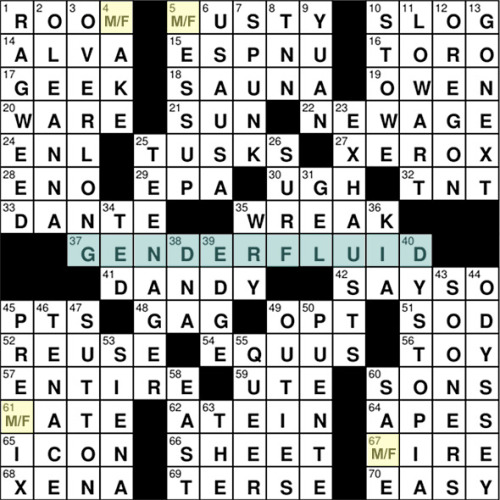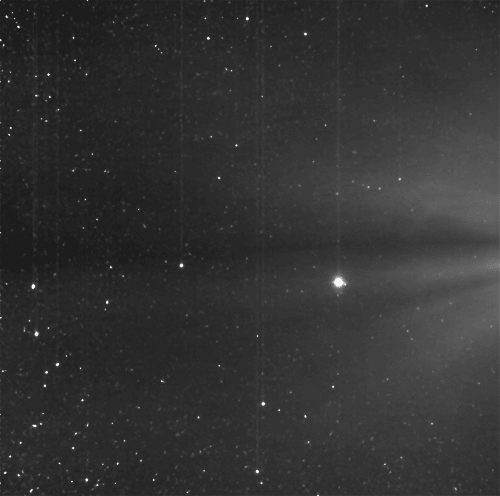Sometimes It Amazes Me That The Juno Spacecraft Was Originally Designed Without Any Cameras Onboard.


Sometimes it amazes me that the Juno spacecraft was originally designed without any cameras onboard. The JunoCam instrument has produced stunning imagery of Jupiter thus far and shows no signs of stopping soon. The latest wonder is this false-color, high-contrast animation showing the motion of Jupiter’s clouds swirling and flowing past one another.
Now, this is not Jupiter as you would see it by eye. This animation is derived from two images taken 8 minutes and 41 seconds apart. In that time, Juno covered a lot of distance, so the two images had to be mathematically re-projected so that they appeared to be taken from the same location. Then, by comparing relative positions of recognizable features in the two photos and applying some understanding of fluid mechanics, observers could calculate the probable flow between those two states. Although this is a coarse example, it’s the same kind of technique often used in fluid dynamical experiments when measuring how flows change between two images. (Image credit: NASA/JPL/SwRI/MSSS/G. Eichstädt, source; via EuroPlanet; submitted by Kam-Yung Soh)
More Posts from Plutoisnotaplanet and Others


i’m in a long distance relationship with the stars

“Pluto, the newest planet,” & “Neptune, next to farthest planet.” Buck Rogers’ Space World. ca. 1940. Rumsey. Chart detail.

Scientists just spotted an adorable star that barely even qualifies as one
Sometimes, scientists’ categories for things can be a little demeaning. For example: the “failed star” designation for objects that are larger than planets but smaller than stars.
About 600 light-years away, EBLM J0555-57Ab just barely missed the failed star category. But as will be published in an upcoming issue of the journal Astronomy & Astrophysics, it’s just a hair over the boundary, making it one of the smallest stars we know of.
“Failed star” is actually a factual statement — it just means something isn’t large enough to manage to bang hydrogen atoms together to form helium, the basic process at the heart of a burning star.
EBLM J0555-57Ab looks a bit like it shouldn’t have made the cut: It’s only a tiny bit larger than Saturn, or about one-twelfth the size of our sun. Read more (7/12/17)
follow @the-future-now

This was the crossword puzzle in the New York Times yesterday.
Tausig’s crossword is a so-called Schrödinger puzzle, named for the physicist’s hypothetical cat that is at once both alive and dead. In a Schrödinger puzzle, select squares have more than one correct letter answer: They exist in two states at once. “Black Halloween animal,” for example, could be both BAT or CAT, yielding two different but perfectly correct puzzles. Only 10 such puzzles have now been published in Times history.
It’s the theme of Tausig’s puzzle, though, that makes it special. Four entries in Thursday’s crossword can include either an “F” or an “M.” Both are correct; neither is wrong. For example, “Part of a house” can be either ROOF or ROOM. The long “revealer” answer, tying those select entries together and spanning 11 squares smack-dab in the middle of the puzzle, is GENDER FLUID.
This puzzle, with “M”s and “F”s that aren’t fixed, is a masterful blend of subject and structure. “It potentially really evokes what gender fluidity is, which is not moving back and forth between two poles, but actually not being committed to either pole, and potentially existing in many states at different times,” Tausig said.

im a hipster guys, im about the size of russia i could go to starbucks
To some people you’re an NPC
To other people, you’re the special, unlockable character that they worked and worked to finally get- and when they do they’re so happy because they got the game just so they could find you.
Pluto x Eris
i guess you could say their relationship is...strictly plutonic

stars, mercury, and solar corona, photographed by stereo a, january 2009.
27 frames, photographed over 36 hours, 2nd-3rd january. the sun is out of frame right.
image credit: nasa/stereo. animation: ageofdestruction.

-
 lovelym0rningsun reblogged this · 1 year ago
lovelym0rningsun reblogged this · 1 year ago -
 anussstart reblogged this · 2 years ago
anussstart reblogged this · 2 years ago -
 calypsomode liked this · 2 years ago
calypsomode liked this · 2 years ago -
 halldorudo liked this · 2 years ago
halldorudo liked this · 2 years ago -
 techjum reblogged this · 4 years ago
techjum reblogged this · 4 years ago -
 mynewone1234 reblogged this · 6 years ago
mynewone1234 reblogged this · 6 years ago -
 marvolousmonster liked this · 6 years ago
marvolousmonster liked this · 6 years ago -
 watershipdrown liked this · 6 years ago
watershipdrown liked this · 6 years ago -
 captainblucifer reblogged this · 6 years ago
captainblucifer reblogged this · 6 years ago -
 captainblucifer liked this · 6 years ago
captainblucifer liked this · 6 years ago -
 combdoc reblogged this · 6 years ago
combdoc reblogged this · 6 years ago -
 leonardcohenofficial liked this · 6 years ago
leonardcohenofficial liked this · 6 years ago -
 februarywhite reblogged this · 6 years ago
februarywhite reblogged this · 6 years ago -
 sisypheanstruggle liked this · 6 years ago
sisypheanstruggle liked this · 6 years ago -
 alexmcfadden liked this · 6 years ago
alexmcfadden liked this · 6 years ago -
 orbgoo liked this · 6 years ago
orbgoo liked this · 6 years ago -
 noizycat liked this · 6 years ago
noizycat liked this · 6 years ago -
 spaceap liked this · 6 years ago
spaceap liked this · 6 years ago -
 bekstek reblogged this · 6 years ago
bekstek reblogged this · 6 years ago -
 bold-sartorial-statement liked this · 6 years ago
bold-sartorial-statement liked this · 6 years ago -
 ellendd reblogged this · 6 years ago
ellendd reblogged this · 6 years ago -
 lawsontl reblogged this · 6 years ago
lawsontl reblogged this · 6 years ago -
 jukebox-head liked this · 6 years ago
jukebox-head liked this · 6 years ago -
 torenhoog reblogged this · 6 years ago
torenhoog reblogged this · 6 years ago -
 endeeringghosts liked this · 6 years ago
endeeringghosts liked this · 6 years ago -
 shadowknight1224 liked this · 6 years ago
shadowknight1224 liked this · 6 years ago -
 the-sad-little-fallen-angel reblogged this · 6 years ago
the-sad-little-fallen-angel reblogged this · 6 years ago -
 the-sad-little-fallen-angel liked this · 6 years ago
the-sad-little-fallen-angel liked this · 6 years ago -
 messier51 reblogged this · 6 years ago
messier51 reblogged this · 6 years ago -
 dreamypaleblue reblogged this · 6 years ago
dreamypaleblue reblogged this · 6 years ago -
 suzyxn liked this · 6 years ago
suzyxn liked this · 6 years ago -
 beachbeachfeet reblogged this · 6 years ago
beachbeachfeet reblogged this · 6 years ago -
 justanotherwebpage liked this · 6 years ago
justanotherwebpage liked this · 6 years ago -
 spiltcandycoatedpunkblood liked this · 6 years ago
spiltcandycoatedpunkblood liked this · 6 years ago -
 theannoyedglitchysylph liked this · 6 years ago
theannoyedglitchysylph liked this · 6 years ago -
 mifuneshimura liked this · 6 years ago
mifuneshimura liked this · 6 years ago -
 the-nomadic-writer liked this · 6 years ago
the-nomadic-writer liked this · 6 years ago -
 a-square-6-28-496 reblogged this · 6 years ago
a-square-6-28-496 reblogged this · 6 years ago -
 reclusify liked this · 6 years ago
reclusify liked this · 6 years ago -
 i-love-broccolis reblogged this · 6 years ago
i-love-broccolis reblogged this · 6 years ago -
 i-love-broccolis liked this · 6 years ago
i-love-broccolis liked this · 6 years ago -
 just-evo-now liked this · 6 years ago
just-evo-now liked this · 6 years ago -
 opt-math-zation liked this · 6 years ago
opt-math-zation liked this · 6 years ago -
 salt-and-bramble liked this · 6 years ago
salt-and-bramble liked this · 6 years ago
welcome to my space space (see what i did there) (space means two different things)
232 posts